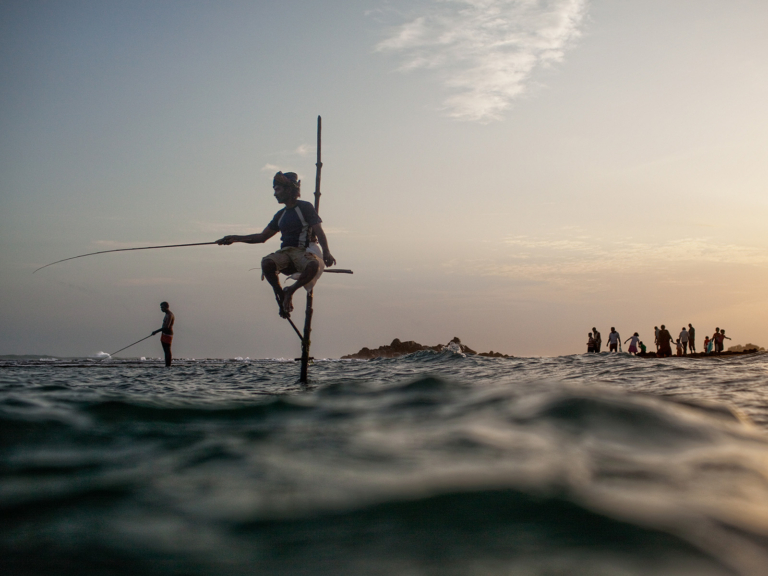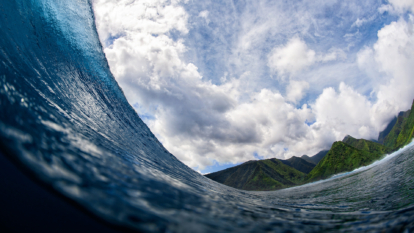Our Hero
Trying to address the climate crisis without the ocean will not work.
Do you remember the first time you had your feet in the sand and looked out at the ocean? How enormous and blue. How impressive and intriguing. As a little kid, I quickly looked from the magic of waves down to the sand and shells. The ocean was … a bit too much to get my head around. And as my parents taught me to swim, the mantra was: Never turn your back on the ocean; stay alert to avoid getting pummeled, or worse. As an adult, my respect for the ocean’s power only deepened as I became a marine biologist and focused my work on climate solutions. My concern deepened, too.
To date, 66 percent of marine environments have been severely altered by human actions—pollution from oil spills, agriculture, factories, plastics; coastal ecosystems bulldozed to farm shrimp and build resorts; the plunder of overfishing causing fish populations to plummet; the deep sea on the brink of being mined and torn up for minerals; seawater heating up and acidifying, thus driving fish toward the poles, disintegrating coral reefs and fueling hurricanes that decimate communities; and the slower moving catastrophe that is sea level rise.
Oof. That was perhaps as overwhelming for you to read as it was for me to write. For sure, we must keep our eyes on all that and work to halt it. But we also need to seize solutions the ocean offers for abandoning fossil fuels, expanding justly sourced renewable energy, sequestering tons of carbon, supporting coastal economies, and creating a sustainable food system. In fact, when you add it all up, ocean solutions could provide 21 percent of the greenhouse gas emission reductions needed to limit the world’s temperature rise to 2.7 degrees Fahrenheit (1.5 degrees Celsius). We are clearly overdue for a reframe from seeing the ocean only as a victim, or threat, to rightly appreciating it as a hero.

Kimi Werner freedives in Tonga. Photo: Perrin James
An ocean of solutions
We must not turn our backs on the ocean’s power to heal. Many of us are familiar with how the ocean can heal us emotionally—which we should probably make better use of in these wild times—but we’re less familiar with the ocean’s ability to help stabilize the climate. So far, the ocean has absorbed over 90 percent of the excess heat trapped by greenhouse gases, without which our atmosphere would be around 64.8 degrees Fahrenheit (36 degrees Celsius) hotter. It has also absorbed around 30 percent of atmospheric carbon dioxide emitted by burning fossil fuels. But as a result, the ocean is less hospitable for sea life—it has warmed by 1.58 degrees Fahrenheit (0.88 degrees Celsius) and become 30 percent more acidic.
Along with mitigating the pollution and heating of the atmosphere, the ocean has incredible potential for producing renewable offshore energy—now primarily wind power, but perhaps in the future wave, tidal and other forms as well. For example, in the US, one-third of energy demand could be met by offshore wind. Over 30 percent! This alternate energy will be a critical component of rapidly transitioning away from polluting fossil fuels and eliminating the economic and ecological devastation caused by oil spills.
At the same time, though, resist the temptation to think only about technological fixes. Nature and the process of photosynthesis are a big part of the solutions we have at our fingertips. Coastal ecosystems can often provide cheaper and more effective shoreline protection than hard structures, such as seawalls. They also enhance food security and support coastal economies. The value of the global ocean economy is conservatively estimated at $1.5 trillion (projected to double by 2030) and directly supports 31 million full-time jobs. So let’s talk some more about all that.
Kill fewer fish and protect more places
There is no simpler way to convey how woefully underappreciated the ocean is than the fact that less than 3 percent of it is fully protected. Not only is that pathetic, but it’s also a very long way from the 30 to 50 percent that scientists recommend is needed to ensure ecosystem integrity and biodiversity preservation.
Similar to national parks on land, marine protected areas (MPAs) provide safe havens for ocean life to rebound from damaging human activities. This is especially true of marine reserves (MPAs closed to all fishing) that, when large and well-enforced, provide a multitude of benefits within and beyond their boundaries. A recent meta-analysis concluded:
The widespread establishment of MPAs can, in a cost-effective fashion, help slow climate change, alleviate some of its expected hardships (e.g., reduced food security, sea level rise), reduce biodiversity loss, help safeguard critical ecological processes underpinning the planetary life-support system, and improve the outlook for recovery after greenhouse gas emissions have been brought under control.
That’s a quintuple win. We love to see it.
Three examples come to mind. In Southern California, MPAs that reduced the fishing area by 35 percent led to a 225 percent increase in total catch in surrounding areas after six years. Since MPAs have no walls, when fish populations rebound inside their boundaries, they enhance catches outside their boundaries via “spillover” of larvae and adult fish.
In Baja California, Mexico, when a climate-driven oxygen depletion caused a mass die-off of pink abalone, the abalone population came back faster within the healthier ecosystems of marine reserves.
And research on the Great Barrier Reef in Australia shows that coral reefs that bleached due to heat stress recover faster in protected areas. MPAs can improve the resilience of marine species and ecosystems to changing ocean conditions—critical given the dire state of the climate crisis.
Marine reserves are not the only solution, and they alone are not enough—we still need to end overfishing, habitat destruction and pollution, and, of course, address climate change. Also, returning management authority to local Indigenous groups can be a key element of ocean conservation, as can co-management by governments and tribal authorities.
Then there’s the vast high seas, the very poorly managed two-thirds of the ocean far from the coast and human habitation that no one “owns.” Closing the high seas to fishing is a much-needed and overdue step. This year, the United Nations came close to passing the High Seas Treaty to achieve that, but delegates failed to reach consensus; that effort must also continue.
If protecting 30-plus percent of the ocean and closing the high seas to fishing sound extreme to you, consider that nearly 94 percent of fish populations are either overfished or fished to their maximum sustainable yield. Technologies developed for war—radar, sonar, helicopters, spotter planes—are used to seek and catch the remaining fish. Wild fish can’t make babies fast enough to keep up with our plunder. Yet around 3 billion people rely on seafood as a significant source of protein. The adage about teaching a man to fish doesn’t work if there are no fish to catch.
Biggie Smalls rapped “remember when we had to eat sardines for dinner” as a sign of poverty. But that’s actually what we should be eating: small, fecund fish rich in omega-3s, not top predators like tuna, whose numbers have plummeted by more than 50 percent (bluefin by 97 percent in 2016) since we got a taste for them. Or better yet …

Stilt fishermen await a strike on Sri Lanka’s southern coast. This method began after World War II, when competition was fierce and spots were overcrowded. Early adopters perched atop boat wreckage before transitioning to today’s balancing act. Photo: Florian Mueller
Farm the ocean, regeneratively
Along with stronger and expanded protections, let’s farm the ocean instead of hunt it. I don’t mean industrial salmon farms that pollute the water and require tons of feed. For food security and sustainability, the future must include seaweed and shellfish farms dotting our coastlines. With regenerative ocean farming, mussels flourish on hanging ropes while oysters and clams grow in cages on the seafloor, and kelp thrives on lines in between it all.
As ocean-farming pioneer Bren Smith explains in The Ocean Solution (a Patagonia Provisions film), this is all done without fertilizer, fresh water or feed. Through photosynthesis and the formation of shells, ocean farms absorb tons of carbon, a climate solution that also creates habitat for a cornucopia of wildlife and could create up to 50 million direct jobs globally. A single acre of ocean can produce up to 10 tons of seaweed and 250,000 shellfish in just about five months.
Not only is seaweed a super nutritious food for us, but when certain sea veggies are incorporated into cattle feed, it can reduce the methane (a potent greenhouse gas) in livestock belches by 50 percent. Seaweed can also be used to make bioplastics and biofuels. A true utility player.
Restore coastal ecosystems
Zooming out from the magic of seaweed, coastal ecosystems are underrated. Disturbing these ecosystems inhibits ongoing carbon sequestration and releases previously stored carbon. Up to 1 billion tons of carbon dioxide are released annually from degraded and destroyed coastal ecosystems. And worse, this destruction also releases massive amounts of methane, a potent greenhouse gas. Releases! These are ecosystems that should be absorbing carbon, and we are turning that on its head.
In Southeast Asia, extensive swathes of coastal mangroves have been bulldozed for shrimp aquaculture. When the tsunami hit in 2004, locations without mangroves were the most severely impacted because residents were left without natural protection from the deadly flooding. Likewise in the Mississippi Delta. By the time Hurricane Katrina hit in 2005, southern Louisiana had already lost more than 1,900 square miles of wetlands, so there wasn’t enough left to buffer the power of the storm. Similarly, New York City was once surrounded by roughly 15 square miles of wetlands and an abundance of oysters. This coastal city is now largely unprotected, with no wild oyster reefs to speak of and almost 85 percent of its coastal wetlands lost in the last century. But what little remains prevented nearly $140 million in flood damages during Superstorm Sandy in 2012. Poor and working-class folks, disproportionately people of color and renters, were the most vulnerable to the storm and some are still feeling its effects 10 years later.
When communities pursue gray infrastructure (concrete) instead of green infrastructure (nature), the price tag can be astronomical. Coastal ecosystems often provide better and less expensive flood and storm protection than seawalls. If we leave them intact and restore them, they’ll protect us.

Growing in rough, shallow waters, bull kelp forests provide shelter for ocean species and help protect coastlines, serving as a buffer from harsh ocean waves. Vancouver Island, British Columbia. Photo: Eiko Jones
Moving out of harm’s way
Fueled by the warmer waters associated with global warming, ultrapowerful storms are now regular occurrences—stronger winds, more rain, faster increases in strength—and their season is getting longer due to climate change. In 2022, Hurricanes Fiona and Ian devastated the Caribbean, killing more than 100 people and causing hundreds of millions of dollars in damage. Such storms can be especially devastating for communities of color and poor and working-class communities that were already at a disadvantage, and have fewer resources with which to recover. These storms entrench and exacerbate inequality.
It doesn’t make sense to keep rebuilding in the same places. It is pure hubris to think we can hold back the ocean. And refusing to plan for the inevitable only makes it worse. This is not only true in the wake of storms but also when it comes to sea level rise.
As ice melts, the ocean swells. As seawater warms, it expands. Global mean sea level has already risen about 8 inches (20 centimeters) and could rise another meter or more by the end of the century. This will force a mass exodus from coastal areas, creating many millions of climate migrants. In Bangladesh, for example, which produces only 0.4 percent of global carbon emissions, it is expected that 17 percent of the land will become submerged, displacing 20 million people by 2050. Entire communities in Isle de Jean Charles, Louisiana, and Oakwood Beach on Staten Island, New York, have already had to relocate. Next are Native Alaskan villages like Newtok (the subject of a Patagonia Films® documentary), parts of Miami and the Carolinas (including Princeville, the first town chartered by African Americans).
We must find just ways to help communities move out of harm’s way and say goodbye to some of the coastal places we treasure. And when that happens, we need ways to mourn that loss, then adapt and stay connected.

Photo: Ray Collins
Pursuing ocean justice
When we think about ocean conservation, the first things that come to mind are often fish, dolphins, whales, coral and remote tropical islands. Yet ocean conservation is just as much about people; it’s also a matter of justice.
Communities of color and of poor and working-class folks are often either excluded from accessing ocean resources or relegated to the most denuded and polluted places. Although they bear the greatest brunt of the impacts of climate change and pollution, they’ve often had the least hand in causing them. When we think about how to pursue ocean conservation, restoration and climate solutions, we must also think about ocean justice. How we go about ocean conservation and the implementation of ocean-climate solutions really matters.

Photo: Ray Collins
A recent effort in this direction is the Ocean Justice Forum, which I had the honor of co-leading. Eighteen organizations representing a broad cross section of coastal communities—from Indigenous kelp farmers in Alaska, to fishermen in New England, to Latina surfers in California, to Native Hawaiians, and Black folks in the Gulf of Mexico—came together to develop a set of principles and priorities for putting justice at the heart of ocean policy. To get 18 organizations to develop a consensus policy platform feels like a small miracle. (And now over 40 additional groups have signed on. Patagonia was one of the first.) In the end, it can be summarized quite simply.
An equitable and just approach to ocean policy must:
- Protect the ocean and the benefits it provides for all.
- Alleviate the disproportionate burdens placed on ocean justice communities due to ocean pollution.
- Promote an economy that sustains the ocean and the communities that rely on it.
- Uplift justly sourced renewable energy from the ocean.
- Prioritize community social cohesion in disaster response and adaptation investments.
We now have a road map to a future of ocean justice.
While all the ways in which the ocean has been degraded can feel very heavy— the stakes are indeed enormous—remember how this article started: The ocean brims with solutions. The ocean is severely threatened, but it is also resilient. With robust, just policies, community action and corporations doing their part, the ocean can be a core element of our climate solutions—sequestering carbon, protecting shorelines, producing renewable energy, providing nutritious and sustainable seafood, and supporting hundreds of millions of good jobs.
Frankly, we have not been giving the ocean the respect it deserves, and that must change. A healthy ocean is critical to food security, economies, cultures and our own health. Trying to address the climate crisis without including the ocean simply will not work.
Onward to salty climate solutions and ocean justice.

